AUGUST 14, 2016 — “What if this is a huge mistake?” asks Parker while gazing down toward the end of the Trans-Catalina Trail, which has nearly been subsumed by the post-sunset dusk. “It’s almost dark, and we might run into a bison. Maybe we should turn around.”
I’m astonished. Though this is Parker’s first backpacking trip, and we have walked a surprisingly challenging 41 miles (66 kilometers) over the past three days across California’s Catalina Island, this is the first time she has said anything negative, let alone expressed any doubt about finishing the trip. But, we’re only 1.5 miles from the end of the trail.
“Parker, we’re only a mile away, and you wanted to get to Starlight Beach by sunset tonight,” I say. “We can’t turn back now.”
Only a week before this moment, Parker and I were sitting in a Los Angeles sports bar, ostensibly watching Parker’s alma mater team (University of Alabama) win the National Championship, but mostly dreaming of ideas for winter travel and outdoor adventures.
“What about the Trans-Catalina?” Parker suggested. “This is a perfect time of year for it.”
“Yes! I have wanted to do that for years, and I think it’s a pretty easy trip!” I said. “You know, I have time now to take four days — would you be able to go right away, like next week?” I asked.

In 1924, a Hollywood film crew brought fourteen bison to Catalina Island, California to shoot a movie.
And, so, after a handful of days of planning, an overnight stay at Catalina’s perfectly chic Pavilion Hotel, and some exceptionally yummy swordfish tacos at Luau Larry’s bar next door, Parker and I set out one morning along Catalina’s coastline to start trekking across the island.
“What are the trash bags for?” Parker asked, as we looked back at the unique, shiny, circular Catalina Casino sitting at the edge of the water. Since she had never tackled a multi-night backpacking trip before, she diligently packed everything on my suggested packing list, which some ultralight backpacking aficionados might argue is a tad too comprehensive.
“I don’t know, exactly,” I said. “But, I always need them for something.”
“Do you think we’re going to see bison?” Parker asked. “That’s the only thing that really scares me.” In 1924, a Hollywood film crew brought fourteen bison to Catalina to shoot a movie, but, after the studio canceled the shoot, the crew never returned the buffalo to the wild. Today, Catalina has over 150 mostly docile bison roaming the island, though in one recent incident, a land surveyor had to be airlifted to a hospital in Los Angeles after being gored by one of the bison only 4 months before our trip.
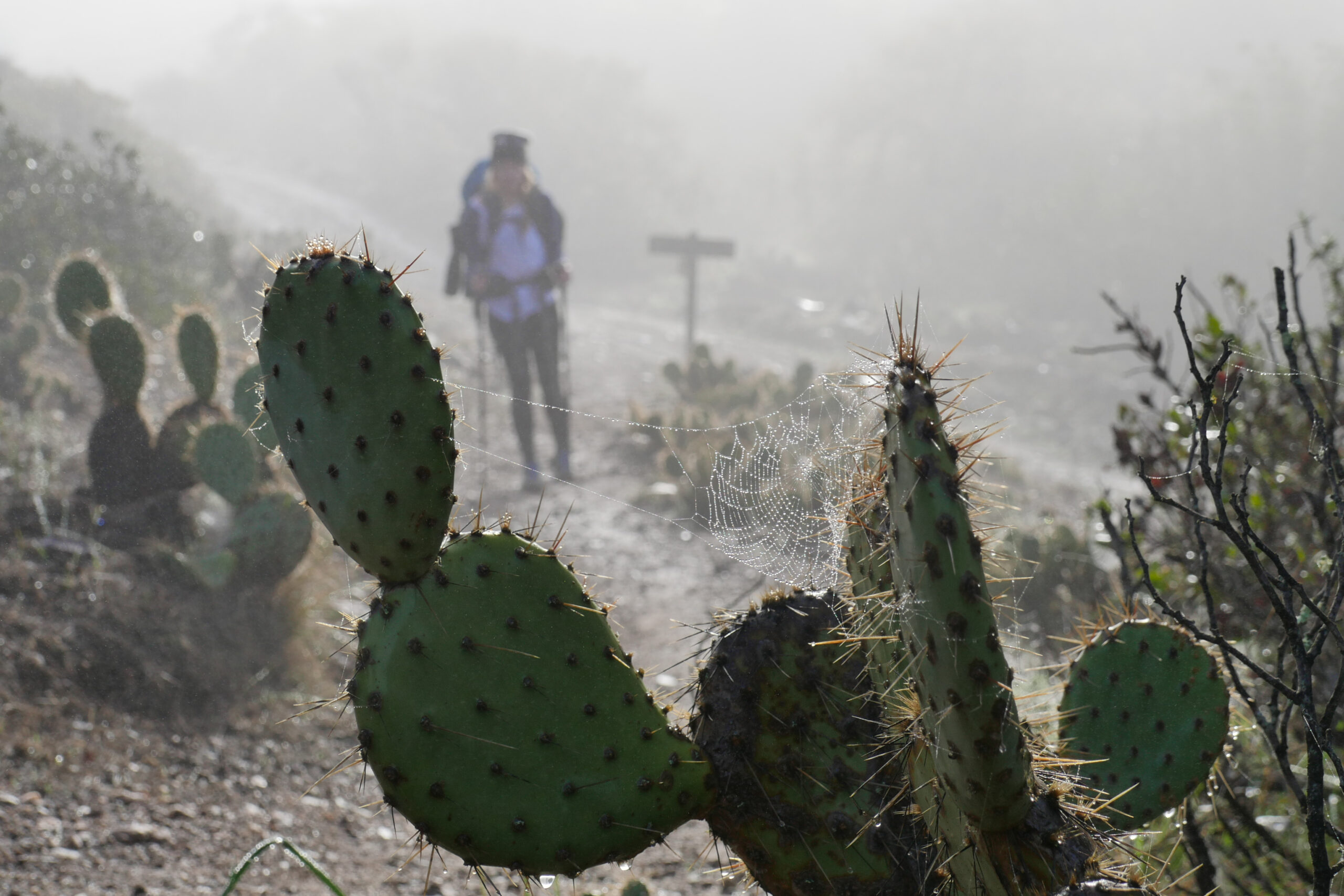
A spider web sits on a prickly pear in front of a hiker on the Trans-Catalina Trail.
“I doubt we need to worry much,” I said. “I bet we won’t even see one.”
After a scenic hike along the coastline, an interesting jaunt through a seldom-seen industrial part of Avalon, Catalina’s biggest harbor town, and a climb up a “shortcut,” the two of us arrived at the Trans-Catalina Trailhead. We were off on our adventure.
Over the course of the next ten hours, we realized quickly that not only is the Trans-Catalina Trail not easy, but it’s an exceptionally challenging backpacking trip. The Trail’s first five miles demands that hikers climb over 1,600 feet (500 meters) to the first day’s high point, and the relentless rolling hills that follow are a test of endurance. On the way up, we met a man named Travis, carrying a surprisingly small backpack, who told us that he lived in South Dakota and had just cycled for six weeks from Las Vegas to Los Angeles and then decided to walk the Trans-Catalina by himself. We hiked and talked with him for a few minutes, but, soon, he left us behind due to the astounding stamina he developed cycling.
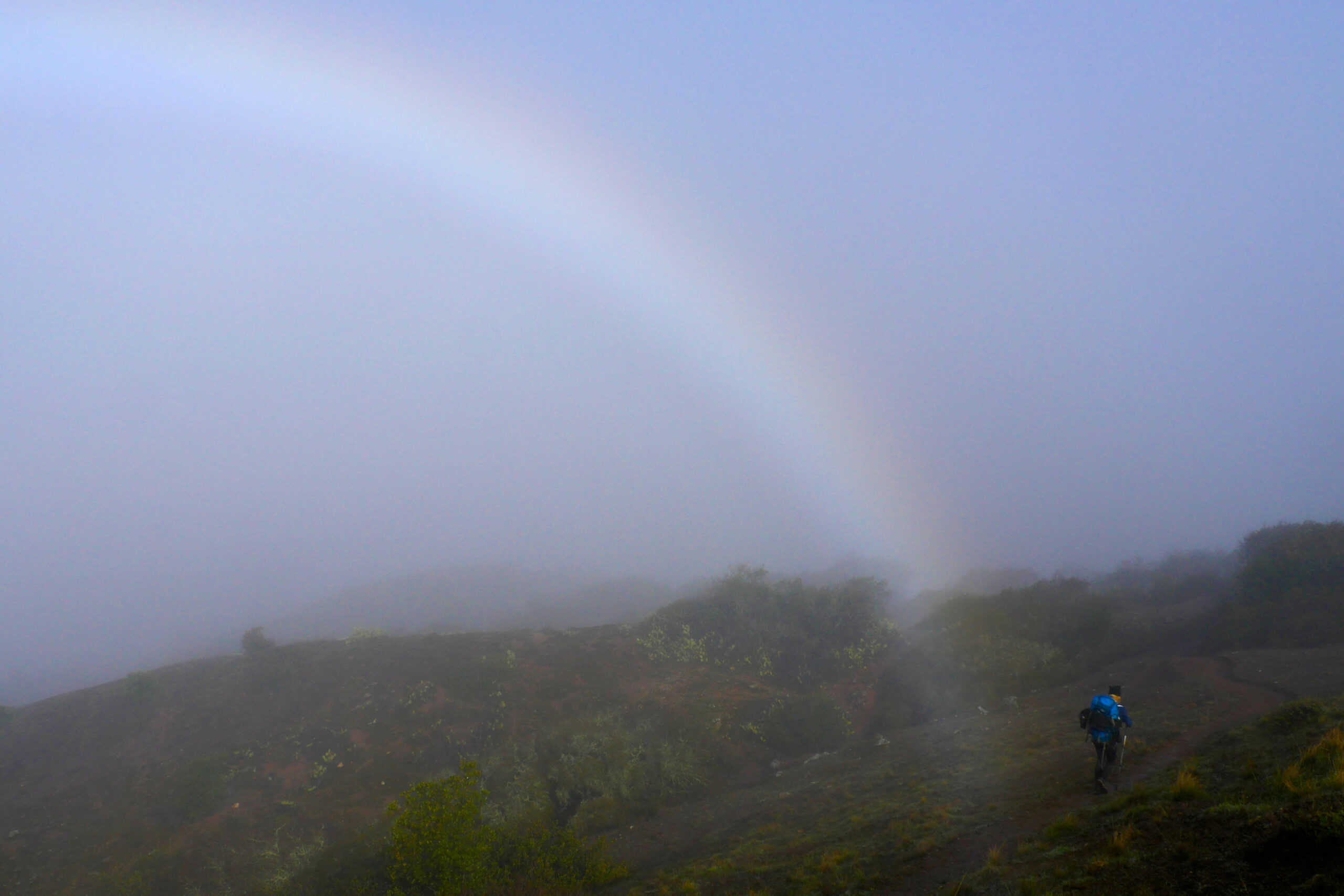
A hiker walks by a morning rainbow on the Trans-Catalina Trail.
Only a few minutes later, just before lunch, Parker and I spotted a bison, about a half-mile away from us on a bluff, near a reservoir.
“Don’t walk toward it!” Parker urged. But, we realized quickly that the trail didn’t lead anywhere near the lumbering animal, and we continued hiking. When the impatient winter sun set around 5 PM, it became obvious that we didn’t start hiking early enough in the morning, given that we still had two miles of climbing remaining to get to Black Jack Campground. We were near the top of our final 500-foot climb when Parker heard a rustling sound ahead of us in the dark.
“What is that?!” Parker whispered.
“Probably just the rain or the wind,” I said.
“Wait, there’s a bison right in front of us!” Parker said. “I see it. I see it! We just woke it up!”
I shined my headlamp into the inky night in front of us, but I saw only darkness. I was about to tell Parker that she was imagining things when, suddenly, I saw two eerie blue points of light reflected from my headlamp. I realized that they were the eyes of a bison, the largest indigenous land mammal in North America, and he was standing only 100 feet from us in the dark. We were terrified.
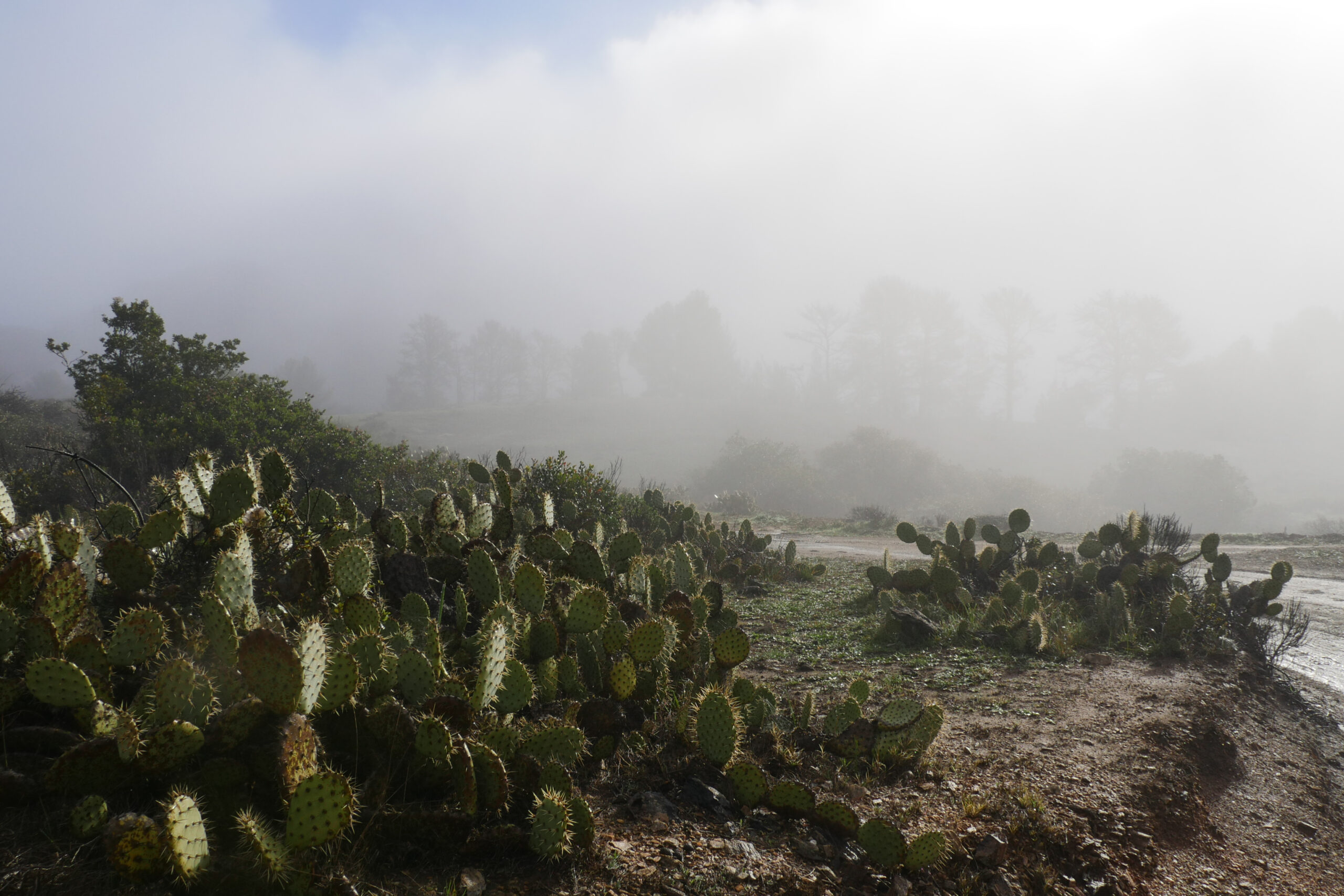
Prickly pear patches line the Trans-Catalina Trail near the Airport in the Sky.
“What do we do? What do we do?” Parker whispered. “What if he charges at us?”
“I don’t know! I don’t know!” I said. “We should have Googled this.”
Scared, the two of us backed away very slowly and then followed the trail away from the bison, toward Black Jack, until we finally found our campsite.
“It’s definitely already an adventure,” Parker said as we nestled into our sleeping bags, relieved not to have been killed by an angry bison. We fell asleep listening to the sound of light rain vibrating on the tent’s rain fly.
In the morning, we awoke to a dew-covered world. Parker spread one of her plastic trash bags on the seat of a nearby picnic table to avoid getting our pants soaked while we enjoyed morning coffee. Then, after a slow packing process, we climbed 2.5 miles and 700 feet through dense fog and sprawling prickly pear patches to the Airport in the Sky, an airport built in the late 1930s near Catalina’s highest elevation. There, we ate a big breakfast burrito and veggie burger, did some Googling about bison safety, and then dropped 1,500 feet to Little Harbor on the island’s south coast, only to begin a 1,800-foot (550-meter) ascent and descent over rust- and celery-colored mountain peaks on the way to Two Harbors, back on the island’s north coast. We were rewarded with seemingly infinite, sparkling blue ocean views, but the grueling climbs and descents meant that the sun again left us behind with two miles remaining to Two Harbors Campground.
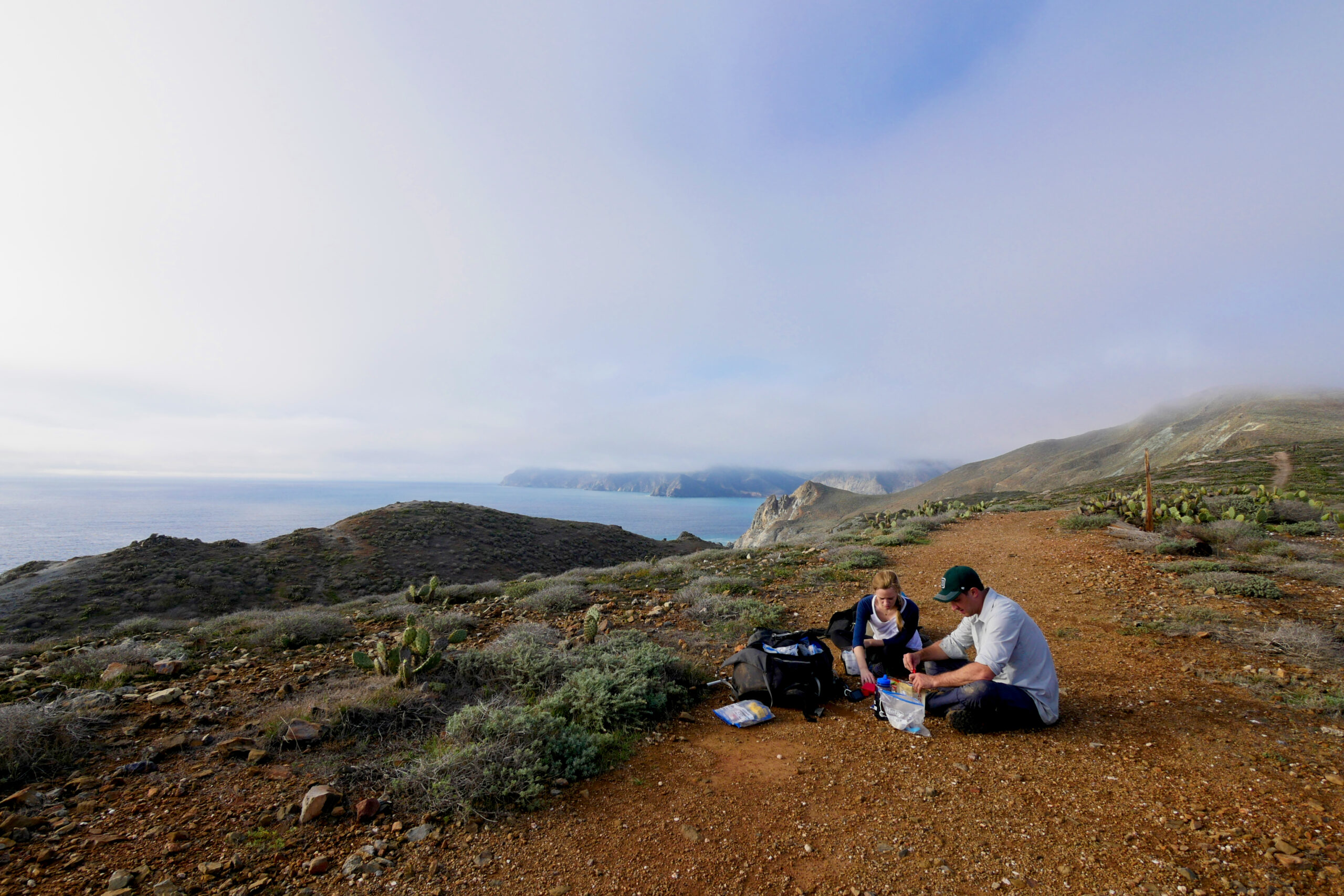
Hikers stop to eat lunch at a viewpoint above Little Harbor on the Trans-Catalina Trail.
“The bison seem to come out on the trail at night,” Parker said, nervously. “We’ve gotta get there fast.” Suddenly, Parker stopped walking and stared into the darkness ahead. “Wait, what is that? Is it a bush? No, it’s another bison!” Parker said.
“It’s probably just a bush growing in the trail,” I said, suspecting Parker had become paranoid due to last night’s unexpected encounter.
“Then why is the bush moving?!” Parker asked.
Shining my headlamp toward the “bush,” I realized that she was right; there they were again: the tell-tale blue reflections from the bison’s eyes.
“That is so crazy,” I said. The bison was standing right in the middle of the trail, staring at us, so we decided to walk around him off trail, hoping to avoid disturbing him. But, as we were walking around, we heard the bison pawing the ground, which, we read earlier, is one of the signs that bison might charge imminently. We froze in our hiking shoes again.
“What is he doing?” Parker whispered. Suddenly, we heard the huge 1,300-pound (600-kilogram) bison start running at full speed. “Oh no, is it coming toward us?!”
Immediately, though, we realized that the sounds of the bison’s hooves were diminishing, and the bison was running away from us. Nervously, we continued down the trail, with Parker still wondering whether every bush was a bison waiting to pounce. Surprisingly, when we arrived at Two Harbors Campground, we encountered yet another bison blocking the path to our campsite. By now, Parker’s bison paranoia didn’t seem crazy anymore. After skirting bison number four, we ran into our friend Travis again.
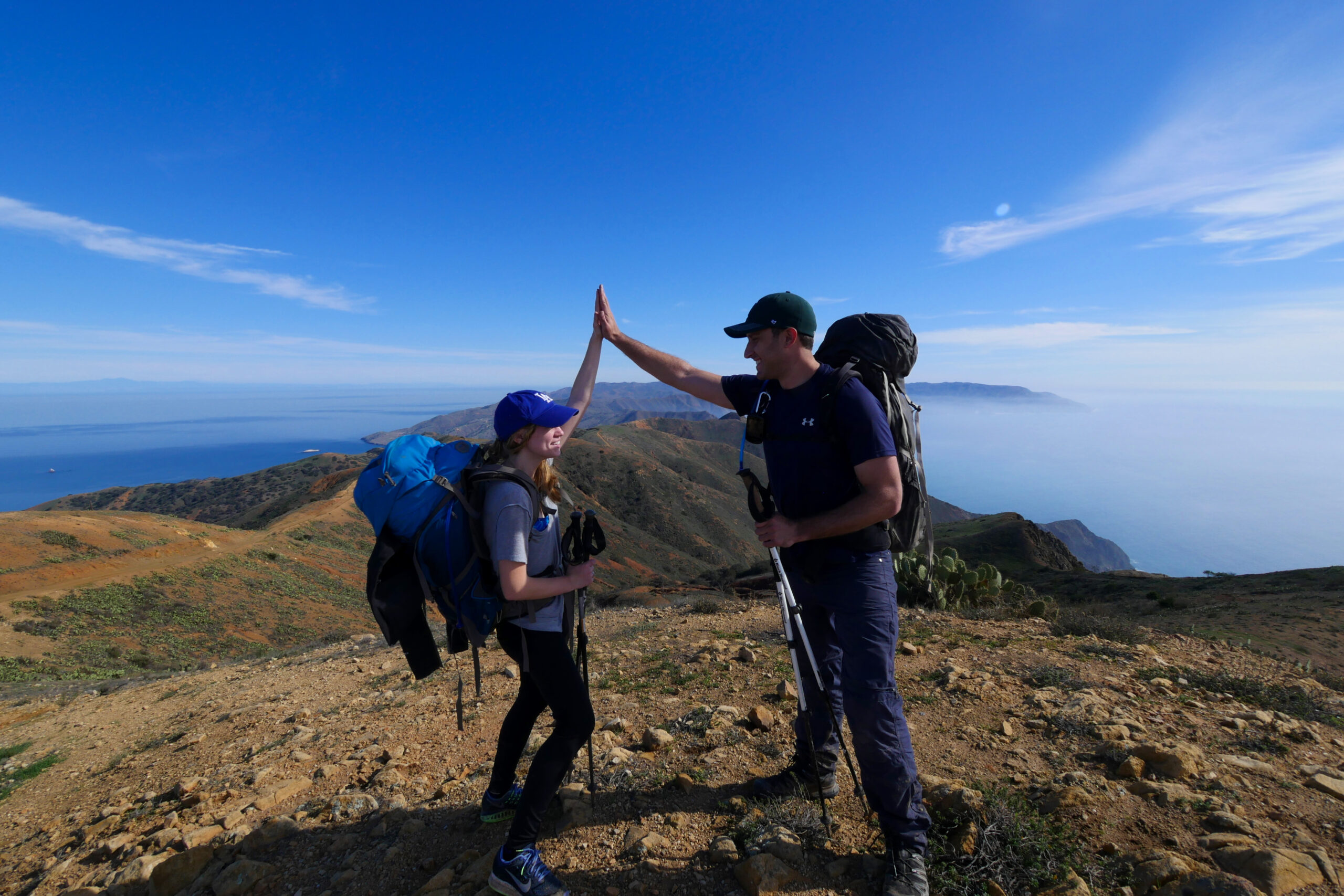
Hikers high-five at the Trans-Catalina Trail’s high point at 1,800 feet.
“Did you guys see that bison wandering around the camp?” Travis asked. “You can kind of sense their personalities. This one seems like a chill dude.”
Parker’s looked skeptical, but she eventually became used to having a pet bison in camp, and the two of us settled into the tent for the night. In the end, Travis was right — the chill-dude bison didn’t seem very interested in us.
By the time we woke up in the morning, both Travis and the bison were gone. Over the next four miles, the “trail” — which was really just a dirt road not designed for backpacking at all — climbed nearly 2,200 feet (670 meters), without any switchbacks. To give an idea how difficult this section of the hike was with heavy backpacks, it’s worth noting that one of the National Park Service’s guides for trail construction standards recommends that no trail have a grade exceeding 10 percent for more than 100 feet. In contrast, the “trail” from Two Harbors to Parsons Landing has a section with a 13.5 percent average grade for 2.2 miles straight. Even for the two-hour hike down from the top, the trail has an average grade of near 11 percent for a three-mile stretch, which, with heavy backpacks, is almost harder than climbing up. Whoever decided to designate a hodgepodge of Catalina’s dirt roads as a hiking trail almost certainly had no experience building trails and had never been hiking or backpacking in their lives.
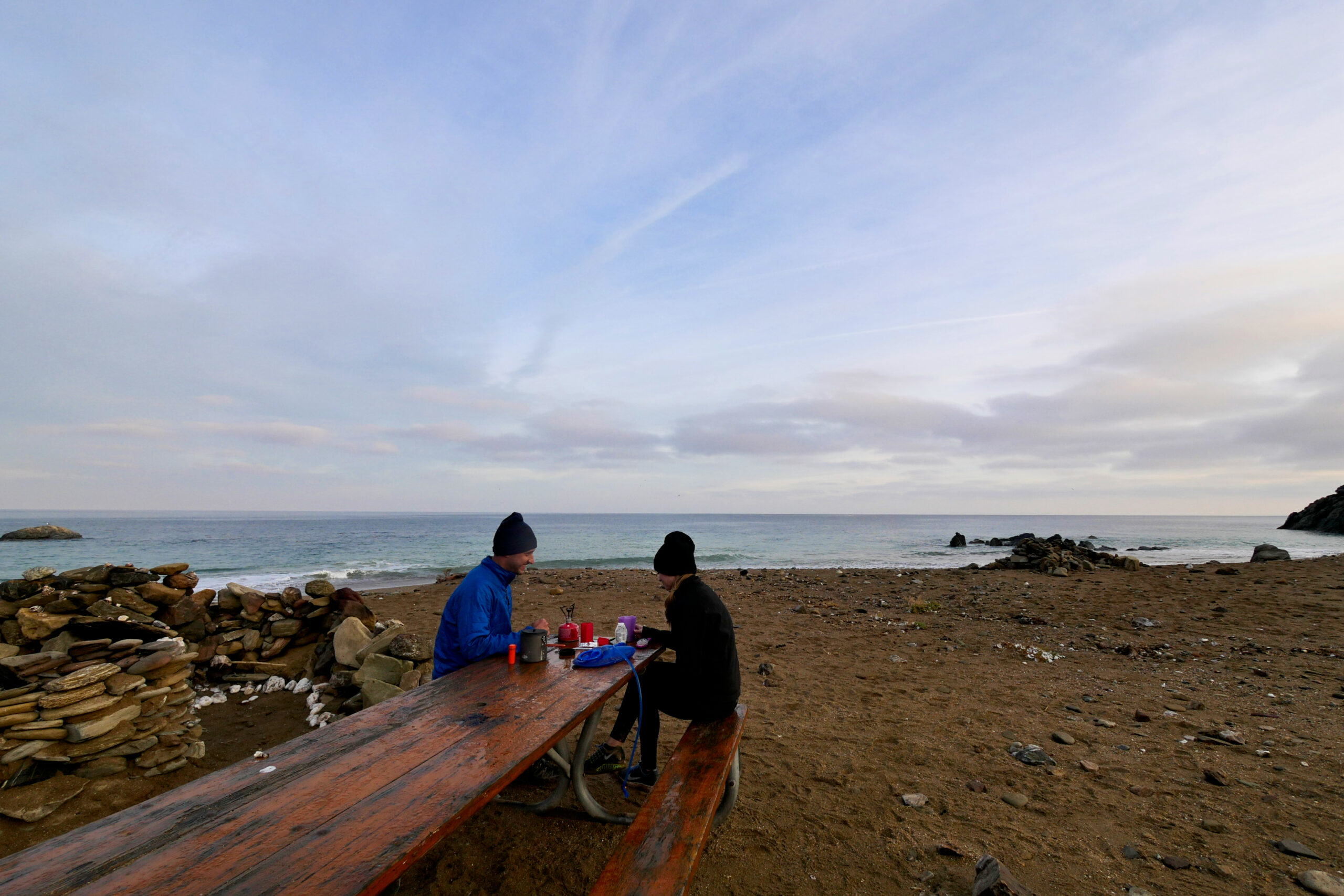
Hikers make coffee in the morning at a picnic table at Parsons Landing on Catalina Island, California.
Nevertheless, Parker and I pushed on. Parker’s energy seemed boundless, but my stamina started to wane. When we reached the trail’s high point, we celebrated with some candied pecans and gummy bears, which gave me a burst of speed and strength for the trip down to the beach. But, when we finally reached Parsons Landing after six hours and an additional 2,000-foot down-climb, the idea of hiking the day’s remaining 9 miles to the end of the trail at Starlight Beach and back seemed miserable.
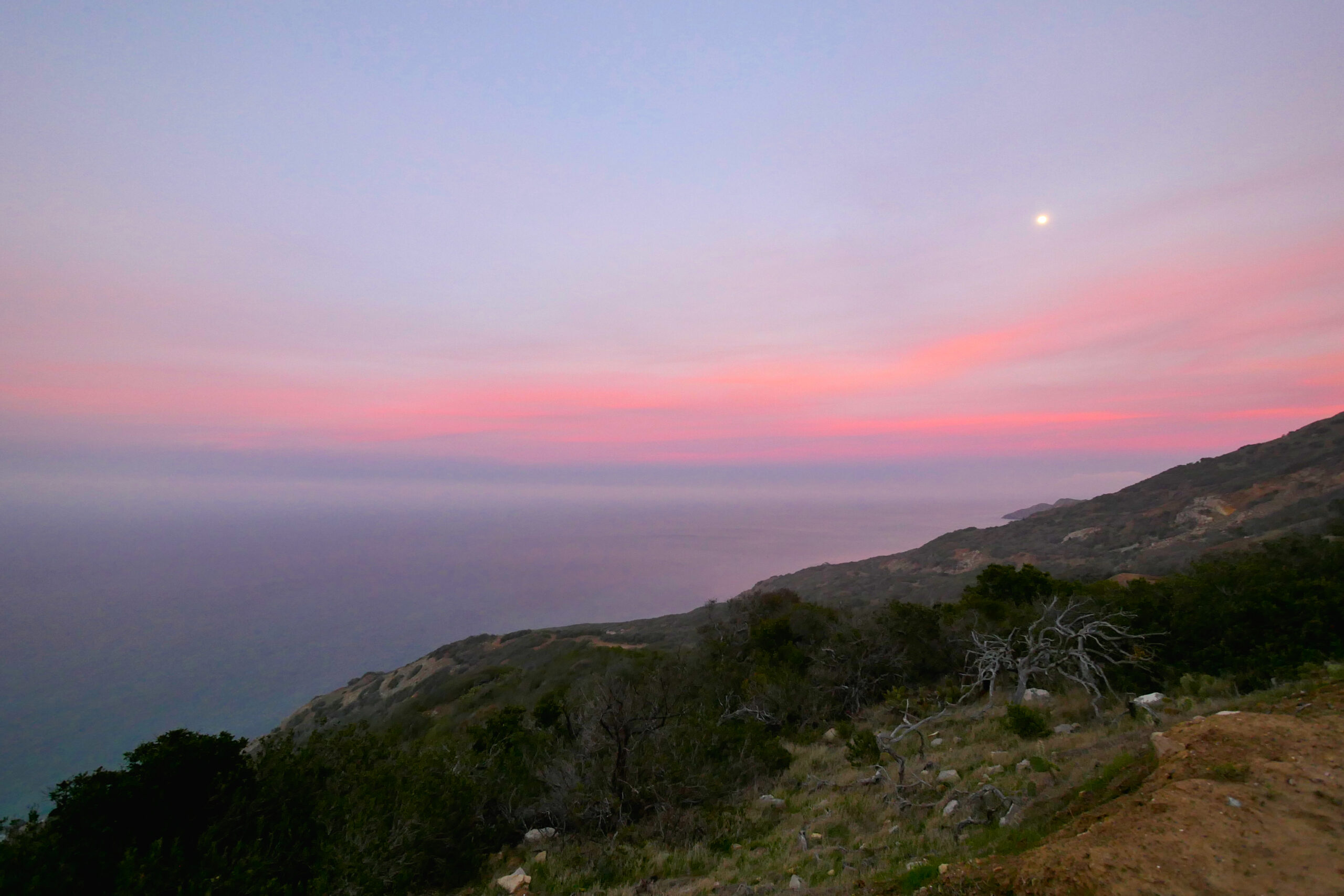
A full moon illuminates the Trans-Catalina Trail at sunset on Catalina Island, California.
“Maybe we should finish the trail tomorrow instead,” I suggested to Parker.
“I kind of want to get to Starlight by sunset,” Parker said. “Can we try?”
So, after a big lunch, we left most of our gear at the beach and and started off toward Starlight with only our dinner and two hours remaining before nightfall. On the way, immediately before a steep uphill section of trail, we ran into Travis again.
“Oh no, do we have to go up that steep hill?” I asked him.
“Yeah, just climb up that and then you only have about two miles left,” he said as he rushed off toward Parsons Landing to try get back before dark. Though I feel a pang of embarrassment that Parker and I have never made it to our camp before dark during our entire trip, I still feel proud that we’ve managed to hike every mile super-fit Travis has, despite Parker’s inexperience and my recent lack of gym and hiking time.
Nevertheless, this is the moment when Parker loses her will.
“Two more miles?! What if this is a huge mistake? It’s almost dark, and we might run into a bison. Maybe we should turn around.”
The impressive thing to me about Parker is that, even now, when I can barely lift my leg for one more step, it’s not that her endless energy has been exhausted or her indestructible will has been destroyed. She’s just understandably afraid of being gored by a bison in the dark, over 10 miles from any help.
“Parker, we’re only a mile away and you wanted to get to Starlight Beach by sunset tonight,” I say. “We can’t turn back now. You could have convinced me a couple miles ago, but we’re so close!”

Hikers cook dinner at dusk above Starlight Beach at the end of the Trans-Catalina Trail on Catalina Island, California.
Reluctantly, she agrees to go just a bit father as long as we don’t see any bison, and, two miles later, with only a few glimmers of orange and purple sunlight dancing above the horizon, we arrive at Starlight Beach, the end of the Trans-Catalina Trail. When we collapse together on a ledge above the surf to start cooking our dinner, Parker pulls out a Nalgene water bottle filled with wine to celebrate. After all, Parker has completed her first backpacking trip ever, and I’ve completed one of the most physically strenuous short (three-day) backpacking trips I’ve ever done.
I don’t mention it to Parker, but I have a sneaking suspicion that yet another chill-dude bison is standing above us on a bluff, secretly watching us eat. I imagine that, to him, the hikers arriving at Starlight Beach to celebrate their victory night after night are like Bison Netflix. As Parker and I drink wine and recount our trip’s best stories under the moonlight, I imagine that the bison and his friends are celebrating too: congratulating themselves on making sure that all Trans-Catalina hikers feel accomplished by forcing them to pass through a nearly impenetrable bison gauntlet.
“I loved the hike,” Parker says as she devours her macaroni and cheese. “I loved it.”
How to Hike the Trans-Catalina Trail on California’s Catalina Island
OVERVIEW: The Trans-Catalina Trail is a very strenuous four-day, 55-mile (89-kilometer) hiking trip — with a total elevation gain and loss of over 12,000 feet (3,700 meters) — across Catalina Island, a 22-mile-long island sitting off the coast of California. The Trail starts near the town of Avalon on Catalina’s east end and ends at Starlight Beach on the island’s west end. Though the official Trail itself is a three-day, 40.6-mile (65-kilometer) trip, at the end of the trail, hikers must backtrack 4.7 miles back to Parsons Landing after tagging Starlight Beach and then hike another 7.4 miles back to Two Harbors (the next day) using a separate coastal road to board a ferry to return to the mainland. In addition, starting by walking to the trailhead from Avalon adds an additional one or two miles to the trip, depending on the route taken.
GETTING TO CATALINA: The Catalina Express, the ferry to Catalina Island, leaves daily from San Pedro, Long Beach, and Dana Point (for San Diego dwellers) to Avalon and Two Harbors, the two towns on Catalina Island. Reservations can be made at catalinaexpress.com. Round trip tickets cost an obscene $74.50, proving that a world with a ferry monopoly is a bad world indeed. The easiest way to use the Catalina Express for this trip is to book a ferry from San Pedro to Avalon to start the hike and then book a ferry returning from Two Harbors to San Pedro on the morning at the end of your trip. Ferries leaving Two Harbors only go to San Pedro, so if you arrive in Avalon by taking a ferry from Long Beach or Dana Point, you may need to take a taxi/Uber to retrieve your car.
CAMPSITES: Campsite reservations should be made in advance at reserveamerica.com for Black Jack Campground for the first night, Two Harbors Campground for the second night, and Parsons Landing for the third night. Note that the Catalina Conservancy charges an expensive $17 per person per campsite plus an additional $9.25 per reservation, resulting in a total of $43.25 per campsite per couple. These prices may make hikers think twice about going to hike on an island owned by a private land trust.
LOGISTICS: Though we carried the food we needed for almost every meal on this trip to save money, it’s possible to carry less food by eating breakfast at an Avalon restaurant at the beginning of the first day, breakfast at the Airport in the Sky restaurant at the beginning of the second day, dinner at the Two Harbors restaurant or general store at the end of the second day, and breakfast in Two Harbors at the beginning of the third day. Spigots provide water at Black Jack Campground and Two Harbors Campground, but no water is available while hiking during the day. Hikers must pickup their hiking permit and campsite reservations for Black Jack and Two Harbors at the Atwater Hotel (24 hours per day) in Avalon before leaving for the trip. Maps are available from the Catalina Conservancy in Avalon, but note that the office doesn’t open until 8:30 AM. Hikers must check in at the Visitor’s Center in Two Harbors to pickup their Parsons Landing campsite reservations and locker access. For an extra $20, hikers can pay for access to a locker at Parsons Landing with firewood and 2.5 gallons of water, which most will want to do to avoid having to carry two days of water to Parsons Landing. For those trying to hike with the least weight possible, Catalina Backcountry will transfer a group’s backpacks between campsites during the hike for an wallet-busting $350.
ROUTE: Here is the route and schedule that we followed:
- DAY 1: Avalon to Black Jack Campground (16 mi, 4004 ft gain, 10 hours)
- DAY 2: Black Jack to Two Harbors Campground (14 mi, 3000 ft gain, 14 hours)
- DAY 3: Two Harbors to Parsons Landing (7.7 mi, 2400 ft gain, 6 hours) to Starlight Beach and back (9.4 mi, 2600 ft gain, 6 hours) (total: 17.1 mi, 5000 ft gain, 12 hours)
- DAY 4: Parsons Landing to Two Harbors via the coastal road (7.4 mi, 480 ft gain, 3 hours)
Where did you get your stove fuel? I have not found anywhere on the island to buy the fuel for my Jetboil Flash.
For very small backpacking stoves, you can bring fuel (like small MSR IsoPro canisters) onto the Catalina Express. They'll put the fuel into a special "firebox" to diminish the safety risk and you can get it back when you get off the boat.
Traveling is always a good thing in life, it fill your souls. Willing to visit more beautiful places
Love how conversational your writing is! Felt like I was right there in Catalina with you.
From what I've seen is a typical desert climate in certain parts of the island. I liked the video, congratulations.
The video is awesome. I liked it.